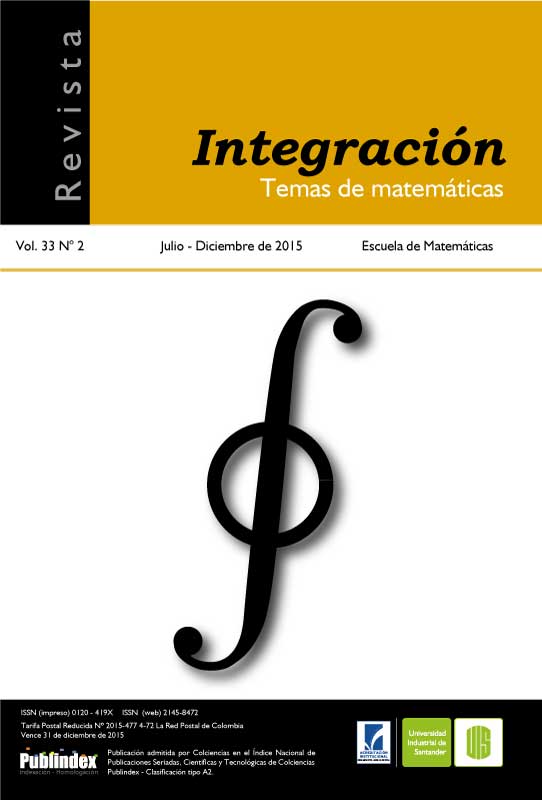Artículos científicos
Publicado 2015-12-04
Palabras clave
- Números Tribonacci,
- triplas diofánticas,
- formas lineales en logaritmos de números algebraicos
Cómo citar
Gómez Ruiz, C. A. (2015). Números Tribonacci, S-unidades y triplas diofánticas. Revista Integración, Temas De matemáticas, 33(2), 121–133. https://doi.org/10.18273/revint.v33n2-2015003
Resumen
La sucesión Tribonacci T := {Tn}n≥0 tiene valores iniciales T0 = T1 =0,T2 =1 y cada término posterior es la suma de los tres términos precedentes. En este artículo, estudiamos la ecuación Tn = kTm, donde k es una S-unidad, para un conjunto finito S de primos. Particularmente, mostramos que cualquier par de miembros de la tripla diofántica {9, 56, 103} asociada a T +1, no se puede extender a otra tripla diofántica asociada a T +1.
Para citar este artículo: C.A. Gómez Ruiz, Números Tribonacci, S-unidades y triplas diofánticas, Rev Integr. Temas Mat. 33 (2015), No. 2, 121–133.
Descargas
Los datos de descargas todavía no están disponibles.
Referencias
- Arkin J., Hoggatt V.E. and Strauss E.G., “On Euler’s solution of a problem of Diophantus”, Fibonacci Quart. 17 (1979), No. 4, 333–339.
- Baker A. and Davenport H., “The equations 3x2 − 2 = y2 and 8x2 − 7 = z2”, Quart. J. Math. Oxford Ser. (2) 20 (1969), 129–137.
- Bugeaud Y. and Dujella A., “On a problem of Diophantus for higher powers”, Math. Proc. Cambridge Philos. Soc. 135 (2003), No. 1, 1–10.
- Bugeaud Y. and Gyarmati K., “On generalizations of a problem of Diophantus”, Illinois J. Math. 48 (2004), No. 4, 1105–1115.
- Bravo J.J. and Luca F., “Powers of two in generalized Fibonacci sequences”, Rev. Colombiana Mat. 46 (2012),
- No. 1, 67–79.
- Cohen H., Number Theory, Vol. I: Tools and Diophantine equations, Springer, New York, 2007.
- Dresden G.P.B. and Du Z., “A simplified Binet formula for k-generalized Fibonacci numbers”, J. Integer Seq. 17 (2014), No. 4, Article 14.4.7, 9 pp.
- Dujella A., “There are only finitely many Diophantine quintuples”, J. Reine Angew. Math. 566 (2004), 183–214.
- Dujella A., “On the number of Diophantine m-tuples”, Ramanujan J. 15 (2008), No. 1, 37–46.
- Elsholtz C., Filipin A. and Fujita Y., “On Diophantine quintuples and D(−1)-quadruples”, Monatsh. Math. 175 (2014), No. 2, 227–239.
- Fuchs C., Luca F. and Szalay L., “Diophantine triples with values in binary recurrences”, Ann. Sc. Norm. Super. Pisa Cl. Sc. (5) 7 (2008), No. 4, 579–608.
- Fuchs C., Luca F. and Szalay L., “Diophantine triples with values in k-generalized Fibonacci sequences” (preprint).
- Gibbs P., “Some rational Diophantine sextuples”, Glas. Mat. Ser. III 41 (2006), No. 2, 195–203.
- Gómez Ruiz C.A. and Luca F., “On the largest prime factor of the ratio of two generalized Fibonacci numbers”, J. Number Theory 152 (2015), 182–203.
- Gómez Ruiz C.A. and Luca F., “Tribonacci Diophantine quadruples”, Glas. Mat. Ser. III 50 (2015), No. 1, 17–24.
- Gómez Ruiz C.A. and Luca F., “Diophantine quadruples in the sequence of shifted Tribonacci numbers”, Publ. Math. Debrecen 86 (2015) No. 3-4, 473–491.
- Gyarmati K., Sárközy A. and Stewart C.L., “On shifted products which are powers”, Mathematika 49 (2002), No. 1-2, 227–230.
- Gyarmati K. and Stewart C.L., “On powers in shifted products”, Glas. Mat. Ser. III 42 (2007), No. 2, 273–279.
- Luca F., “On shifted products which are powers”, Glas. Mat. Ser. III 40 (2005), No. 1, 13–20.
- Luca F. and Szalay L., “Fibonacci Diophantine triples”, Glas. Mat. Ser. III 43 (2008), No. 2, 253–264.
- Luca F. and Szalay L., “Lucas Diophantine triples”, Integers 9 (2009), 441–457.
- Luca F. and Oyono R., “An exponential Diophantine equation related to powers of two consecutive Fibonacci numbers”, Proc. Japan Acad. Ser. A Math. Sci. 87 (2011), No. 4, 45–50.
- Lucas E., “Théorie des fonctions numériques simplement périodiques”, Amer. J. Math. 1 (1878), No. 2-3, 184–240.
- Matveev E.M., “An explicit lower bound for a homogeneous rational linear form in the logarithms of algebraic numbers II”, Izv. Math. 64 (2000), No. 6, 1217–1269.
- Spickerman W.R., “Binet’s formula for the Tribonacci sequence”, Fibonacci Quart. 20 (1982), No. 2, 118–120.
